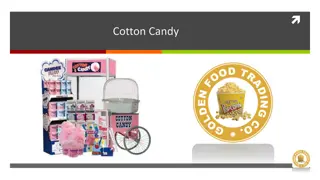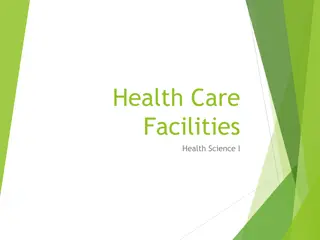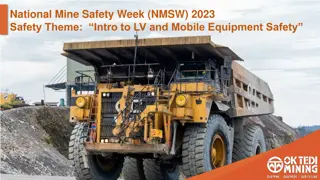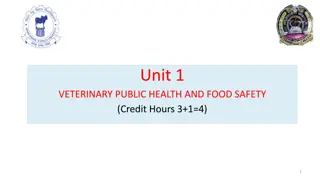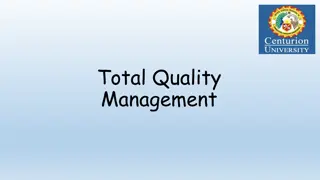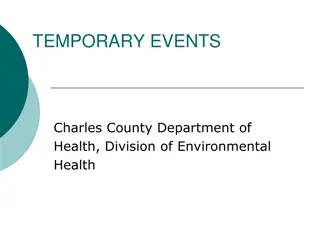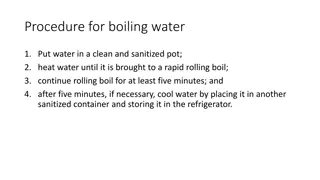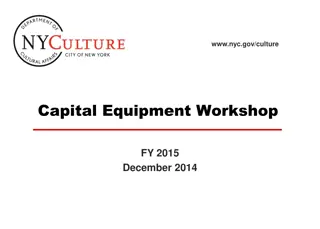Safe Facilities and Equipment Guidelines for Food Service Industry
This chapter covers essential guidelines for safe facilities and equipment in the food service industry. Topics include requirements for flooring, handwashing stations, food-contact surfaces, lighting, garbage handling, and more. Key terms such as porosity, air gap, coving, NSF, backflow, and resiliency are explained in detail to ensure compliance with sanitation standards.
Download Presentation

Please find below an Image/Link to download the presentation.
The content on the website is provided AS IS for your information and personal use only. It may not be sold, licensed, or shared on other websites without obtaining consent from the author. Download presentation by click this link. If you encounter any issues during the download, it is possible that the publisher has removed the file from their server.
E N D
Presentation Transcript
Chapter Number 11 Safe Facilities and Equipment Class Name Instructor Name Date, Semester Book Title Book Author 1
Learning Objectives After this presentation, you should be able to complete the following Learning Outcomes 11.0 11.1 When a review of the construction plan is required 11.2 Characteristics of correct flooring Characteristics of correct interior finishes including doors, walls, and ceilings 11.3 11.4 Requirements for restrooms Requirements for handwashing stations 11.5 11.6 Requirements for food-contact surfaces 2
Learning Objectives After this presentation, you should be able to complete the following Learning Outcomes 11.0 11.7 Organizations that certify equipment that meets sanitation standards 11.8 Requirements for dishwashing facilities 11.9 Requirements for installing equipment 11.10 Approved water sources and testing requirements Methods for preventing cross-connection and backflow 11.11 11.12 The correct response to a wastewater overflow 3
Learning Objectives After this presentation, you should be able to complete the following Learning Outcomes 11.0 11.13 Lighting-intensity requirements for different areas of the operation 11.14 Ways of preventing lighting sources from contaminating food Ways of preventing ventilation systems from contaminating food and food-contact surfaces 11.15 Requirements for handling garbage including correct storage and removal 11.16 The importance of keeping physical facilities in good repair 11.17 4
11.0 KEY TERMS Porosity: Booster heater: Water heater attached to hot-water lines leading to dishwashing machines or sinks. Raises water to temperature required for heat sanitizing of tableware and utensils. Air gap: Air space used to separate a water-supply outlet From any potentially contaminated source. The air space between the floor drain and the drainpipe of a sink is an example. An air gap is the only completely reliable method for preventing backflow. Coving: Curved, sealed edge placed between the floor and wall to eliminate sharp corners or gaps that would be impossible to clean. Coving also eliminates hiding places for pests and prevents moisture from deteriorating walls. Cross-connection: Physical link through which contaminants from drains, sewers, or other wastewater sources can enter a drinkable water supply. A hose connected to a faucet and submerged in a mop bucket is an example. Extent to which water and other liquids are absorbed by a substance. Term usually used in relation to flooring material. NSF: Organization that develops and publishes standards for sanitary equipment design. It also assesses and certifies that equipment has met these standards. Restaurant and foodservice managers should look for an NSF International Mark (or UL EPH product mark) on commercial foodservice equipment. Backflow: Unwanted reverse flow of contaminants through a cross-connection into a drinkable water system. It occurs when the pressure in the drinkable water supply drops below the pressure of the contaminated supply. Resiliency: Ability of a surface to react to a shock without breaking or cracking, usually used in relation to a flooring material.
11.1 When a review of the construction plan is required CONSTRUCTION PLAN REVIEW Before starting any new construction or a large remodeling project, you must check with your regulatory authority. You will need approval of your construction plans before construction begins. While mandatory, a regulatory review of the plans has several benefits: It ensures the design meets regulatory requirements. It ensures a safe flow of food. It may save time and money. It assures that contractors are constructing the facility correctly and approved equipment is being used. In addition to submitting your construction plans to the regulatory authority, you should also check with your local building department to see what is required.
11.2 Characteristics of correct flooring FLOORING Flooring should be smooth, durable, nonabsorbent, and easy to clean. It should resist wear and help prevent slips. Avoid high-porosity flooring, as it is more difficult to keep clean and deteriorates more quickly. Once installed, flooring should be kept in good condition and be replaced if damaged or worn. To prevent these problems, use nonabsorbent flooring in the following areas: Walk-in coolers Prep and food-storage areas Dishwashing areas Restrooms Dressing and locker rooms
11.2 Characteristics of correct flooring FLOORING
11.2 Characteristics of correct flooring FLOORING
11.2 Characteristics of correct flooring FLOORING Use nonslip surfaces in traffic areas. Nonslip surfaces are ideal for the entire kitchen as well, because slips and falls are a potential hazard. For safety reasons, rubber mats are allowed in areas where standing water may occur, such as in the dish room. When scrubbing floors, pick up rubber mats and clean them separately. COVING Coving is required in operations using resilient or hard- surface flooring materials. Coving is a curved, sealed edge placed between the floor and the wall to eliminate sharp corners or gaps that would be impossible to clean. The coving tile or strip should adhere tightly to the wall. This will help eliminate hiding places for insects. It will also prevent moisture from deteriorating the wall.
Characteristics of correct interior finishes including doors, walls, and ceilings 11.3 FINISHES FOR INTERIOR WALLS AND CEILINGS These finishes need to be smooth, nonabsorbent, durable, and easy to clean. Walls and ceilings in prep areas should be light in color to distribute light and to make it easier to spot dirt when cleaning. They should also be kept free of cracks, holes, and peeling paint. Finishes: Cooking Areas: Ceramic tile or stainless steel are common, easy-to-clean choices for walls. Ceiling Materials: Acoustic tile, painted drywall, painted plaster, and exposed concrete Wall and ceiling support structures (studs, joists, and rafters) as well as pipes should not be exposed unless finished and sealed for cleaning. Flexible materials such as paper, vinyl, and thin wood veneers are often used for walls and ceilings. Vinyl wall coverings are popular because they are attractive, relatively inexpensive, easy to clean, and durable. They are also rated for flammability by testing agencies. Plaster or cinder-block walls that have been sealed and painted with oil-resistant, easy- to-wash, glossy paints are appropriate for dry areas of the facility.
11.4 Requirements for restrooms RESTROOMS If possible, provide separate restrooms for staff and customers. Restrooms should be convenient, sanitary, and have self-closing doors. They must be adequately stocked with toilet paper. Garbage containers must be provided if disposable paper towels are used. Women s restrooms also need covered garbage containers for disposing sanitary supplies.
11.5 Requirements for handwashing stations HANDWASHING STATIONS Handwashing stations should be put in areas that make it easy for staff to wash their hands often. These stations are required in restrooms or directly next to them. Handwashing stations are also required in areas used for food prep, service, and dishwashing. Handwashing sinks must be used only for handwashing and not for any other purpose. Make sure these stations work correctly and are well stocked and maintained. They must also be available at all times.
11.5 Requirements for handwashing stations The water must be drinkable and meet temperature and pressure requirements. Soap: The soap can be liquid, bar, or powder. A way to dry hands: Disposable paper towels or a continuous towel system that supplies the user with a clean towel can be used. Hands can also be dried with a hand dryer using either warm air or room-temperature air delivered at high velocity. Garbage container: Garbage containers are required if disposable paper towels are used. Signage: A clearly visible sign or poster must tell staff to wash hands before returning to work. The message should be in all languages used by staff in the operation.
11.6 Requirements for food-contact surfaces 11.6 and 11.7 are only covered through NSF standards see next slide.
Requirements for food-contact surfaces/Organizations that certify equipment that meets sanitation standards 11.6-11.7 Foodservice equipment must meet certain standards if it will come in contact with food. NSF is an organization that creates these national standards. NSF is accredited by the American National Standards Institute (ANSI). NSF/ANSI standards for food equipment require that it be: Nonabsorbent Smooth and corrosion resistant Easy to clean, durable, and resistant to damage. The NSF Mark will appear on equipment that meets these standards. Only commercial foodservice equipment should be used in operations. Household equipment is not built to withstand heavy use.
11.8 Requirements for dishwashing facilities DISHWASHING MACHINES Dishwashing machines vary widely by size, style, and method of sanitizing. High-temperature machines sanitize with extremely hot water. Chemical-sanitizing machines use a chemical solution. The following machines are common in foodservice operations. Single-tank, stationary-rack machine, with doors: This machine holds a stationary rack of tableware and utensils. Items are washed by detergent and water from below, and sometimes from above, the rack. The wash cycle is followed by a hot-water or chemical-sanitizer final rinse. Conveyor machine: With this machine, a conveyor moves racks of items through the various cycles of washing, rinsing, and sanitizing. The machine may have a single tank or multiple tanks.
11.8 Requirements for dishwashing facilities DISHWASHING MACHINES (cont.) Carousel or circular-conveyor machine: This multiple-tank machine moves tableware and utensils on a peg-type conveyor or in racks. Flight type: This is a high-capacity, multiple-tank machine with a peg-type conveyor. It may also have a built-in dryer. Batch-type, dump: This stationary-rack machine combines the wash and rinse cycles in a single tank. Each cycle is timed. The machine automatically dispenses both the detergent and the sanitizing chemical or hot water. Wash and rinse water are drained after each cycle. Recirculating, door-type, non-dump machine: This stationary- rack machine is not fully drained of water between cycles. The wash water is diluted with fresh water and reused from cycle to cycle.
11.9 Requirements for installing equipment INSTALLING AND MAINTAINING KITCHEN EQUIPMENT Stationary equipment should be easy to clean and easy to clean around. In the photo, the dishwasher is installed so that the floor underneath can be cleaned easily.
11.9 Requirements for installing equipment INSTALLING AND MAINTAINING KITCHEN EQUIPMENT Installing kitchen equipment Follow the manufacturer s directions when installing equipment. Also check with your regulatory authority for requirements. In general, stationary equipment should be installed as follows. Floor-mounted equipment Put floor-mounted equipment on legs at least6 inches (15 centimeters) high. Another option is to seal it to a masonry base. Table-top equipment Put tabletop equipment on legs at least 4 inches (10 centimeters) high. Or seal it to the countertop.
11.9 Requirements for installing equipment INSTALLING AND MAINTAINING KITCHEN EQUIPMENT Seal all cracks or seams to prevent food buildup or pests. However, do not use sealant to cover wide gaps from faulty construction or repairs. Any gaps should be correctly repaired before equipment is installed. Maintaining Equipment Once you have installed equipment, make sure it is maintained regularly by qualified people. Also set up a maintenance schedule with your supplier or manufacturer. Check equipment regularly to be sure it is working correctly.
Approved water sources and testing requirements 11.10 WATER SUPPLY Each regulatory authority establishes standards for water in its jurisdiction. Only water that is drinkable can be used for prepping food and come in contact with food-contact surfaces. This water may come from the following sources: Approved public water mains Private water sources that are regularly tested and maintained Closed, portable water containers Water transport vehicles
Approved water sources and testing requirements 11.10 WATER SUPPLY (cont.) If your operation uses a private water supply, such as a well, rather than an approved public source, check with your regulatory authority for information on inspections, testing, and other requirements. Nonpublic water systems should be tested at least each year. The report should also be kept on file in the operation.
Methods for preventing cross-connection and backflow 11.11 CROSS-CONNECTIONS The greatest challenge to water safety comes from cross-connections. A cross-connection is a physical link between safe water and dirty water, which can come from drains, sewers, or other wastewater sources. A cross-connection is dangerous because it can let backflow occur. Backflow is the reverse flow of contaminants through a cross-connection into a drinkable water supply. Backflow can be the result of pressure pushing contaminants back into the water supply. It can also happen when high water use in one area of an operation creates a vacuum in the plumbing system that sucks contaminants back into the water supply. This is called backsiphonage.
Methods for preventing cross-connection and backflow 11.11 CROSS-CONNECTIONS The best way to prevent backflow is to avoid creating a cross-connection. The only sure way to prevent backflow is to create an air gap. An air gap is an air space that separates a water supply outlet from a potentially contaminated source.
The correct response to a wastewater overflow (Prevention?) 11.12 GREASE CONDENSATION AND LEAKING PIPES Grease condensation in pipes is another common problem in plumbing systems. Grease traps are often installed to prevent the buildup of grease from creating a drain blockage. If used, grease traps must be: Easily accessible Installed by a licensed plumber Cleaned periodically according to the manufacturer s recommendations Overhead wastewater pipes or fire-safety sprinkler systems can also leak and become a source of contamination. Even overhead lines carrying drinkable water can be a problem. Check all pipes often to ensure they appear in good condition anddo not leak. They should be serviced immediately when leaks occur.
The correct response to a wastewater overflow (Prevention?) 11.12 SEWAGE It is absolutely essential to prevent them from contaminating food or food-contact surfaces. If there is a backup of raw sewage in the operation, the affected area should be closed right away. the problem must be corrected and the area thoroughly cleaned. If the backup is a significant risk to the safety of food, service must be stopped and the local regulatory authority must be notified. The facility must have adequate drainage to handle all wastewater. Any area subjected to heavy water exposure should have its own floor drain. The drainage system should be designed to prevent floors from flooding.
Lighting-intensity requirements for different areas of the operation 11.13 LIGHTING Different areas of the facility have different lighting-intensity requirements. Regulatory authorities usually require prep areas to be brighter than other areas. Lighting intensity requirements are shown in the table below. Contact the regulatory authority for requirements in your jurisdiction. 50-foot candles (540 lux) in prep areas 20-foot candles (215 lux) in: Handwashing or dishwashing areas Buffets and salad bars Displays for produce or packaged food Utensil storage areas Wait stations Restrooms Inside some pieces of equipment (e.g., reach-in refrigerators) 10-foot candles (108 lux) Inside walk-in coolers and freezer units Dry-storage areas Dining rooms (for cleaning)
Ways of preventing lighting sources from contaminating food 11.14 PREVENTING CONTAMINATION FROM LIGHTING SOURCES Once the correct level of lighting has been installed in each area, you need to monitor it: Replace any bulbs that have burned out. Make sure they are the correct size as well. All lights should have shatter- resistant light bulbs or protective covers. These products prevent broken glass from contaminating food or food- contact surfaces.
Ways of preventing ventilation systems from contaminating food and food-contact surfaces 11.15 VENTILATION Ventilation improves the air inside an operation. It removes heat, steam, and smoke from cooking lines. It also eliminates fumes and odors. If ventilation systems are not working correctly, grease and condensation will build up on walls and ceilings.
Ways of preventing ventilation systems from contaminating food and food-contact surfaces 11.15 VENTILATION (cont.) To prevent this, clean and maintain ventilation systems according to manufacturer s recommendations and/or your local regulatory requirements. Mechanical ventilation must be used in areas for cooking, frying, and grilling. Ventilation must be designed so that hoods, fans, guards, and ductwork do not drip onto food or equipment. Hood filters or grease extractors need to be tight fitting , easy to remove, and cleaned often. The hood and ductwork should be cleaned periodically by professionals as well.
Requirements for handling garbage including correct storage and removal 11.16 GARBAGE Garbage can attract pests and contaminate food, equipment, and utensils if not handled correctly. To control contamination from garbage, consider the following: Garbage removal Garbage should be removed from prep areas as quickly as possible to prevent odors, pests, and possible contamination. Staff must be careful when removing garbage so they do not contaminate food or food-contact surfaces. Cleaning of containers Clean the inside and outside of garbage containers frequently. Do not clean garbage containers near prep or food-storage areas.
Requirements for handling garbage including correct storage and removal 11.16 GARBAGE (cont.) Indoor containers These must be leak proof, waterproof, and pest proof and easy to clean. Containers must be covered when not in use. Designated storage areas Waste and recyclables must be stored separately from food and food-contact surfaces. The storage of these items must not create a nuisance or a public health hazard. Outdoor containers Place garbage containers on a surface that is smooth, durable, and nonabsorbent. Make sure the containers have tight-fitting lids and are kept covered at all times. Keep their drain plugs in place.
Requirements for handling garbage including correct storage and removal 11.16 GARBAGE (cont.) Indoor containers These must be leak proof, waterproof, and pest proof and easy to clean. Containers must be covered when not in use. Designated storage areas Waste and recyclables must be stored separately from food and food-contact surfaces. The storage of these items must not create a nuisance or a public health hazard. Outdoor containers Place garbage containers on a surface that is smooth, durable, and nonabsorbent. Make sure the containers have tight-fitting lids and are kept covered at all times. Keep their drain plugs in place.
The importance of keeping physical facilities in good repair 11.17 Maintaining Equipment Once you have installed equipment: Make sure it is maintained regularly by qualified people. Set up a maintenance schedule with your supplier or manufacturer. Check equipment regularly to be sure it is working correctly.



